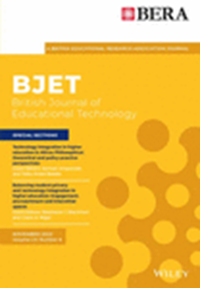Teaching expectancy improves video‐based learning: Evidence from eye‐movement synchronization
IF 6.7
1区 教育学
Q1 EDUCATION & EDUCATIONAL RESEARCH
引用次数: 0
Abstract
Video‐based learning (VBL) is popular, yet students tend to learn video material passively. Instilling teaching expectancy is a strategy to promote active processing by learners, but it is unclear how effective it will be in improving VBL. This study examined the role of teaching expectancy on VBL by comparing the learning outcomes and metacognitive monitoring of 94 learners with different expectancies (teaching, test or no expectancy). Results showed that the teaching expectancy group had better learning outcomes and no significant difference in the metacognitive monitoring of three groups. We further explored the visual behaviour patterns of learners with different expectancies by using the indicator of eye‐movement synchronization. It was found that synchronization was significantly lower in both the teaching and test expectancy groups than in the no expectancy group, and the test expectancy group was significantly lower than the teaching expectancy group. This result suggests that both teaching and test expectancy enhance the active processing of VBL. However, by sliding window analysis, we found that the teaching expectancy group used a flexible and planned attention allocation. Our findings confirmed the effectiveness of teaching expectancy in VBL. Also, this study provided evidence for the applicability of eye‐tracking techniques to assess VBL. What is already known about this topic Video‐based learning has become a popular way, yet students tend to learn video material passively. When students learn with teaching expectancy, they are more likely to engage in deep processing, which has been proven in static multimedia learning. Individuals show high eye‐movement synchronization when watching the same video, and this synchronization may be reduced when they engage in top‐down processing. What this paper adds Teaching expectancy improves learning performance in Video‐based learning. Teaching expectancy enhances active cognitive processing in Video‐based learning. During the video viewing, learners with teaching expectancy not only followed the instructor's explanations but also engaged in active top‐down processing, demonstrating flexible and planned attention allocation. Implications for practice and/or policy Utilizing teaching as an intention can serve as an effective learning strategy for Video‐based learning. The use of eye‐movement intersubject correlation to analyse visual behaviour patterns provides a new way to explore how people learn from dynamic multimedia materials.教学期望能改善视频学习:眼动同步的证据
基于视频的学习(VBL)很受欢迎,但学生往往被动地学习视频材料。灌输教学期望是一种促进学习者主动学习的策略,但它在改善视频学习方面的效果如何还不清楚。本研究通过比较不同期望(教学、测试或无期望)的 94 名学习者的学习成果和元认知监控,研究了教学期望对 VBL 的作用。结果显示,教学期望组的学习效果更好,而三组的元认知监控没有显著差异。我们还利用眼动同步这一指标进一步探讨了不同期待学习者的视觉行为模式。结果发现,教学期望组和考试期望组的同步率都明显低于无期望组,而考试期望组明显低于教学期望组。这一结果表明,教学和测试期望都能增强 VBL 的主动加工。然而,通过滑动窗口分析,我们发现教学期望组采用了灵活而有计划的注意力分配。我们的研究结果证实了教学期望在 VBL 中的有效性。当学生在教学期望下学习时,他们更有可能进行深度加工,这在静态多媒体学习中已经得到了证实。当个体在观看同一视频时,眼动的同步性很高,而当他们进行自上而下的加工时,这种同步性可能会降低。在观看视频的过程中,有教学期望的学习者不仅会跟随教师的讲解,而且还会进行积极的自上而下的加工,表现出灵活而有计划的注意力分配。对实践和/或政策的影响将教学作为一种意图,可作为视频学习的一种有效学习策略。
本文章由计算机程序翻译,如有差异,请以英文原文为准。
求助全文
约1分钟内获得全文
求助全文
来源期刊

British Journal of Educational Technology
EDUCATION & EDUCATIONAL RESEARCH-
CiteScore
15.60
自引率
4.50%
发文量
111
期刊介绍:
BJET is a primary source for academics and professionals in the fields of digital educational and training technology throughout the world. The Journal is published by Wiley on behalf of The British Educational Research Association (BERA). It publishes theoretical perspectives, methodological developments and high quality empirical research that demonstrate whether and how applications of instructional/educational technology systems, networks, tools and resources lead to improvements in formal and non-formal education at all levels, from early years through to higher, technical and vocational education, professional development and corporate training.
 求助内容:
求助内容: 应助结果提醒方式:
应助结果提醒方式:


